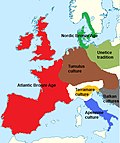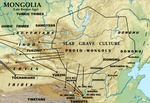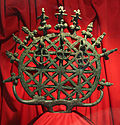the Bohemian groups of the Únětice culture, and later was adapted in Poland and in Germany. Recently, the Únětice culture has been cited as a pan-European...
78 KB (8,273 words) - 15:02, 6 January 2025
Únětice may refer to: Únětice (Plzeň-South District), a municipality and village in the Plzeň Region, Czech Republic Únětice (Prague-West District), a...
356 bytes (75 words) - 13:34, 6 September 2023
continental Europe only until 2300 BC, when it was succeeded by the Únětice culture. The culture was widely dispersed throughout Western Europe, being present...
170 KB (19,734 words) - 23:04, 8 January 2025
river Tisza), and northward into Polish and Central European Únětice territories. The culture's dispersed settlements consisted of villages or homesteads...
23 KB (2,077 words) - 19:38, 5 December 2024
Nordic Bronze Age (category Archaeological cultures of Europe)
those of the Unetice culture, since they brought customs that were derived from Unetice or from local interpretations of the Unetice culture located in...
95 KB (9,958 words) - 01:13, 7 January 2025
Cycladic culture (also known as Cycladic civilisation) was a Bronze Age culture (c. 3100–c. 1000 BC) found throughout the islands of the Cyclades in the...
13 KB (1,529 words) - 07:51, 14 October 2024
the Unetice culture, Ottomány culture, British Bronze Age, Argaric culture, Nordic Bronze Age, Tumulus culture, Nuragic culture, Terramare culture, Urnfield...
27 KB (2,999 words) - 14:36, 31 December 2024
The Karasuk culture (Russian: Карасукская культура, romanized: Karasukskaya kul'tura) describes a group of late Bronze Age societies who ranged from the...
31 KB (3,313 words) - 05:51, 25 November 2024
Terramare culture was a dominant component of the Proto-Villanovan culture—especially in its northern and Campanian phases and the Terramare culture has been...
17 KB (1,874 words) - 13:12, 1 November 2024
Wietenberg culture, a gold axe from Dieskau (Germany) belonging to the Únětice culture, a gold dagger from Inowrocław (Poland) belonging to the Iwno culture, and...
6 KB (664 words) - 10:46, 7 August 2024
which are contemporary with the elite of the Wessex culture, in England, and the Únětice culture, in Central Europe. The extensive documentation of this...
17 KB (1,746 words) - 00:18, 5 July 2024
Catacomb culture. In addition to the Yamnaya culture, the Catacomb culture displays links with the earlier Sredny Stog culture, the Afanasievo culture and...
29 KB (3,432 words) - 20:34, 30 December 2024
The Tagar culture was a Bronze Age Saka archeological culture which flourished between the 8th and 1st centuries BC in South Siberia (Republic of Khakassia...
20 KB (1,924 words) - 10:55, 13 December 2024
northern France and the Unetice culture in central Germany. It is prototyped with the Middle Rhine group of the Bell Beaker culture and commonly subdivided...
6 KB (718 words) - 06:26, 21 March 2024
2nd millennium BC (section Prehistoric cultures)
Cycladic culture Helladic period Minoan civilization Mycenaean Greece Beaker culture Terramare culture Tumulus culture Unetice culture Urnfield culture Central...
20 KB (1,571 words) - 17:37, 3 January 2025
Minoan civilization (redirect from Minoan culture)
The Minoan civilization was a Bronze Age culture which was centered on the island of Crete. Known for its monumental architecture and energetic art, it...
119 KB (14,039 words) - 01:17, 3 January 2025
BC Unetice culture Bronze Age Britain Armorican Tumulus culture Polada culture Pyrenean Bronze Ottomány culture Wietenberg culture Tumulus culture Nordic...
7 KB (602 words) - 20:14, 1 October 2024
The Apennine culture is a technology complex in central and southern Italy from the Italian Middle Bronze Age (15th–14th centuries BC). In the mid-20th...
11 KB (1,253 words) - 14:53, 15 November 2024
in turn found to be closely genetically related to the Beaker culture, the Unetice culture and particularly the peoples of the Nordic Bronze Age. Numerous...
64 KB (7,138 words) - 19:27, 18 December 2024
The Hallstatt culture was the predominant Western and Central European archaeological culture of the Late Bronze Age (Hallstatt A, Hallstatt B) from the...
77 KB (8,530 words) - 13:11, 2 January 2025
Kurgan hypothesis (redirect from Kurgan culture)
prehistoric cultures, including the Yamnaya (or Pit Grave) culture and its predecessors. In the 2000s, David Anthony instead used the core Yamnaya culture and...
34 KB (3,818 words) - 02:41, 26 August 2024
The Urnfield culture (c. 1300–750 BC) was a late Bronze Age culture of Central Europe, often divided into several local cultures within a broader Urnfield...
105 KB (11,119 words) - 14:56, 6 January 2025
burial 6, Late Bronze Age, Srubnaya culture. Trzciniec culture Tumulus culture Nordic Bronze Age Unetice culture "We observed a main cluster of Sintashta...
17 KB (1,790 words) - 20:29, 30 December 2024
during Bz A2–Bz B1 there was an unbroken evolution from the Únětice culture to the Maďarovce culture. There it represents the eastern part of the...
6 KB (622 words) - 05:20, 3 April 2024
Trzciniec culture. The individuals were determined to be closely related to peoples of the Corded Ware culture, Bell Beaker culture, Únětice culture, and the...
10 KB (974 words) - 13:44, 13 November 2024
Individuals from the Bell Beaker culture, the Únětice culture and contemporary Scandinavian cultures were also found to be closely genetically related...
46 KB (4,937 words) - 12:57, 19 December 2024
The Ulaanzuukh culture, also Ulaanzuukh-Tevsh culture (Ch:乌兰朱和文化, c. 1450-1000 BCE), is an archaeological culture of the Late Bronze Age eastern Mongolia...
11 KB (1,186 words) - 02:35, 10 November 2024
The Slab Grave culture is an archaeological culture of Late Bronze Age (LBA) and Early Iron Age Mongolia. The Slab Grave culture formed one of the primary...
33 KB (4,061 words) - 06:05, 6 January 2025
The Lusatian culture existed in the later Bronze Age and early Iron Age (1300–500 BC) in most of what is now Poland and parts of the Czech Republic, Slovakia...
14 KB (1,267 words) - 17:18, 2 December 2024
spans the 2nd millennium BC, (Unetice culture, Urnfield culture, Tumulus culture, Terramare culture and Lusatian culture) lasting until c. 600 BC. The...
103 KB (11,913 words) - 05:48, 3 January 2025
























